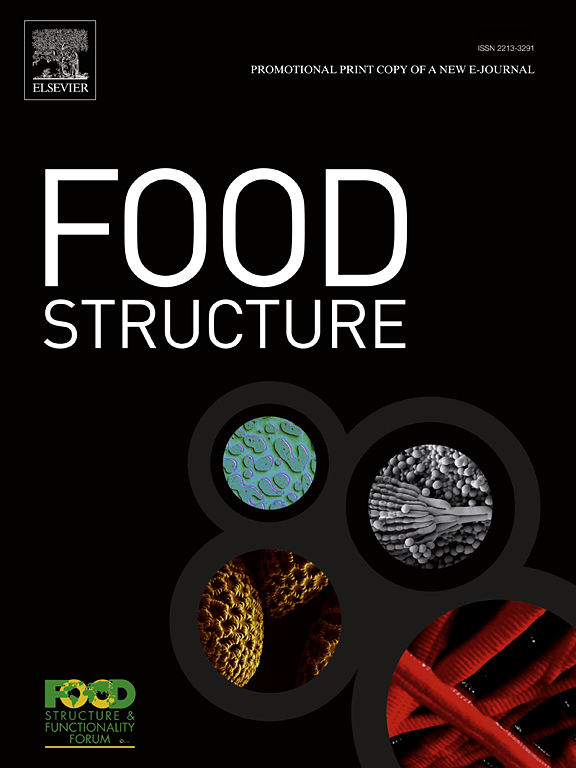乳清蛋白聚集体影响铸膜外观和机械性能。第1部分:直原纤维和非淀粉样聚集体的网络形成
IF 5.9
3区 农林科学
Q1 FOOD SCIENCE & TECHNOLOGY
引用次数: 0
摘要
研究了预处理乳清分离蛋白(WPI)的成膜特性。在本研究的第一部分中,通过酸性ph依赖性热处理,将WPI结构成淀粉样蛋白聚集体。分离的淀粉样蛋白组分(直原纤维)和含有小聚集体和肽的非淀粉样蛋白组分,或两种组分的混合物用于成膜。薄膜的外观和力学性能受介观材料的内聚和粘附作用的影响,影响分层、应力控制和剥离性。通过俯视图照片、扫描电子显微镜和原子力显微镜图像分析表面结构和裂纹模式,表明附着力和内聚力之间的相互作用,并通过纳米压痕测量硬度和弹性。由直、长纤维和非淀粉样聚集体组成的薄膜提供了最高的机械强度和内聚性能。这是由于支架形成的纤维网络,其中嵌入了粘附的非淀粉样蛋白聚集体。在较低的蛋白质浓度下,纤维化通过减少垂直和水平对流流动而使膜轮廓更加均匀。在干燥过程中,骨料的排列在应力释放中起调节作用。因此,已经观察到聚集体形态直接影响所形成裂缝的性质,直原纤维导致直线和线状裂缝。通过研究纯淀粉样蛋白/非淀粉样蛋白薄膜网络获得的见解可以优化WPI薄膜配方,以改进可食用薄膜的应用。这包括减少裂纹形成,增强视觉外观,改善可剥离性。本文章由计算机程序翻译,如有差异,请以英文原文为准。
Whey protein aggregates affect cast film appearance and mechanical properties – Part I: Network formation of straight fibrils and non-amyloid aggregates
The film forming properties of pre-treated whey protein isolate (WPI) were investigated. In part I of this study, WPI was structured into amyloid aggregates via acidic pH-dependent heat treatment. Isolated amyloid fractions (straight fibrils) and non-amyloid fractions containing small aggregates and peptides, or mixtures of both fractions were used for film formation. The films' appearance and mechanical properties were influenced by cohesive and adhesive interactions of mesoscopic materials, affecting delamination, stress control, and peelability. Analysis of surface structure and crack patterns using top-view photographs, scanning electron microscopy, and atomic force microscopy images indicated the interplay between adhesion and cohesion forces, which was supported by measurements of hardness, and elasticity through nanoindentation. Films consisting of straight, long fibrils and non-amyloid aggregates provided the highest mechanical strength and cohesive properties. This was due to the scaffold-forming fibrillar network, in which adhesive non-amyloid aggregates were embedded. Fibrillization led to a more uniform film profile at lower protein concentrations by decreasing vertical and horizontal convection flows. The alignment of aggregates during the drying process demonstrated to play a regulatory role in stress release. As a result, aggregate morphology has been observed to directly affect the nature of the resultant cracks, with straight fibrils resulting in straight and linear cracks. Insights obtained from studying pure amyloid/non-amyloid film networks can optimize WPI film formulations for improved edible film applications. This includes reducing crack formation, enhancing visual appearance, and improving peelability.
求助全文
通过发布文献求助,成功后即可免费获取论文全文。
去求助
来源期刊

Food Structure-Netherlands
Chemical Engineering-Bioengineering
CiteScore
7.20
自引率
0.00%
发文量
48
期刊介绍:
Food Structure is the premier international forum devoted to the publication of high-quality original research on food structure. The focus of this journal is on food structure in the context of its relationship with molecular composition, processing and macroscopic properties (e.g., shelf stability, sensory properties, etc.). Manuscripts that only report qualitative findings and micrographs and that lack sound hypothesis-driven, quantitative structure-function research are not accepted. Significance of the research findings for the food science community and/or industry must also be highlighted.
 求助内容:
求助内容: 应助结果提醒方式:
应助结果提醒方式:


